Workshop Process
This page is a step-by-step guide to the process used in the Visualizing the Invisible workshop in Amsterdam 10-11 July 2014.
Day 1
Scenario development
Framing
What is the workshop about? How will the workshop evolve?
A brief introduction about the usual questions related to what, why, who, when, where and how of the workshop. The framing is given by the organisers (in this case Adam Nocek and Stacey Moran) and the facilitators (Maja Kuzmanovic and Nik Gaffney). The framing should be as short, clear and concise as possible. End with a set of “house rules”, guidelines that set the etiquette for the workshop. If time allows, these rules can emerge from the group. If not, the facilitator can propose the rules and invite the group to comment.
In this workshop, the guidelines could be summarised in three words: trust, listening and presence. Trust is about trusting each other and the process. Go with the flow during the workshop, then share your feedback about the process at the end, during the reflection session. Listening is about hearing instructions and active listening, but most of all listening to each other. Finally, being present means minimising contact with the external world; contributing as much as you can, but staying close to what you need - using your two feet to move away from unproductive conversations where you don't feel you can contribute. Presence also means allowing time for discussions to start and acknowledging when it's time to stop. If anything is unclear or uncomfortable, ask the facilitator rather than waiting and disconnecting from the process.
Introductions
Who is in the room and what are their expectations?
Instruction: All participants sit in a circle. Say your name and three keywords to describe your expectations of the workshop (e.g. creativity, discussion, confusion). While you speak the words, place the snack you brought to share with others in the middle of the circle.
Core question
What are some of the questions (regarding Visualizing the Invisible) that are alive in this group?
Instruction: Consider the topic of the workshop (in this case Visualizing the Invisible). When you think about it, what questions arise in your mind? Speak the question out loud. Listen to each other and try not to interrupt while someone else is offering their ideas.
When all the questions are written on the board, you will be given a sticker (a dot, an arrow…). Chose your favourite question by placing the sticker next to it. At the end the facilitator counts the stickers to find the most popular choice. The question with most votes becomes the core question for the duration of the workshop.
KPU Framework
What is the present situation of the topic at hand? What do we know, presume and don't know about it?
If the group is small enough (5-7 people), the discussion can happen in the group as a whole, in three rounds. For larger groups, the World Cafe method works well:
Instruction: Distribute yourselves across three tables. Each table is tackling a different question. (Pre)assign a moderator, who will take notes, summarise and report about the discussions. There will be three rounds. After each round everyone except the moderators changes tables, so they can discuss all questions. Make sure you shuffle people enough to speak with as many different people as possible. In between the round the moderators summarise the discussions, repeat most salient points to the new groups and continues taking notes. At the end of the three rounds the group comes together as a whole and the moderators report back with summaries of the discussions including all rounds.
Drivers of Change
What drives the changes in the present related to the core question and might therefore impact where the future might be going?
Drivers are large scale forces that can influence significant change across all levels of a system or a culture. Which trends or weak signals are you aware of in the present, that could impact the evolution of visualizing the invisible (positive, negative or neutral)?
If the group is small enough (5-7 people), the discussion can happen in the group as a whole, in several rounds. For larger groups, it's better to work in breakouts. The usual driver categories are known as STEEP (social, technological, economic, environmental and political). You can create a breakout per category, or group some of them to reduce the number of rounds. We grouped them as
- Social and cultural
- Scientific and technological
- Political and economic
- Environmental
Instruction: Distribute yourselves across breakout tables (this can be randomised by printing out words or images that correspond with the topics discussed at the tables). Discuss what might be the relevant drivers of change for (in our case) Visualising the Invisible. At the end of each round, write 3-4 most relevant drivers on post-its (one driver per post-it). Leave them on the table for the next group. Make sure you don't move from one table to another with the whole group, it is best to speak with as many different people as possible. At the end of the four rounds collect the post-its and bring them to the main board of the workshop.
Note: if you are working on a longer term project, consider doing a more in depth horizon_scanning to determine change drivers.
Opening the senses
After lunch, a short meditative exercise, to refocus our senses: mindfully eating dessert.
Instruction: take a piece of dry fruit (or in our case a chocolate covered hazelnut). Begin by examining it visually (colour, shape…), then move to the sense of touch (texture, temperature…), continue with hearing (roughness, softness…), smelling (aromas, volatile components) and finally tasting (with your lips, tongue, teeth, throat… This exercise can take up to 15 minutes.
Critical Uncertainties
What are the most important and most uncertain drivers for our core question?
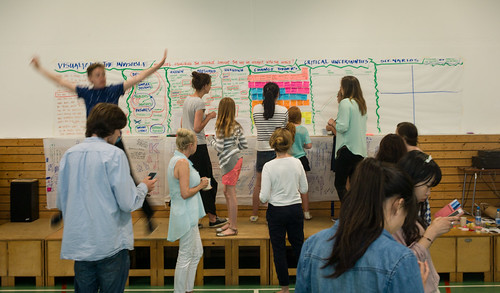
Instruction: each person receives two stickers. Place the stickers on the post-its of the drivers that you find most important for the core question. At the end, transcribe the drivers with at least one sticker onto new post-its.
Draw a line to represent the spectrum of importance: from important, through very important, to extremely important and essential. Place the post-its of important drivers on this spectrum. In a small group this can be done in an informal discussion. In larger groups, some kind of intuitive voting can be used to speed up the process. We used sociometry: we drew the same line on the floor and asked people to move between the stations of important to essential. The facilitators placed the post-its on a relative scale (determining the approximate position based on where the people stood).
The most essential drivers, choose a maximum of ~10 can be selected and examined for uncertainty. The facilitator keeps repeating the question: how certain is it that xxx (the driver) will have an impact on xxx (the topic of investigation)? Again in small groups this can be done through conversation and visualising the “diamond” of uncertainty (that has one side as the importance scale and the other as the uncertainty scale). We continued using sociometry, in the same way as the importance scale.
At the end of this exercise, there should be two most important and most uncertain drivers emerging to the fore. These two drivers can be used as “scenario axes”.
Scenario Skeletons
What's the story?
Draw out the 2×2 scenario matrix and plot the extreme positions of the scenario axes (e.g. in our case open/closed, diverse/homogeneous). If possible create the minimal scenario skeletons with the whole group, so that everyone understands the process before breaking-out to flesh out the details. Keep repeating the core question and asking how the question would be answered from each of the different scenarios. Also look at the combination of the axes and see what kind of stories emerge.
Visible layer
What does this future look like?
Instruction: break out into four scenarios (pick one you feel most drawn to, but make sure there are enough people around each table). Have a conversation guided by the following questions:
- What are the visible characteristics of this world? What is the setting?
- What are the known issues/problems?
- What might be considered big news?
- What might be important events?
- Which behaviours are dominant?
- How would you describe what happens to “visualizing the invisible” in your scenario?
Keep notes on large pieces of paper, so that everyone in the group can read them.
Moodboards
How would you answer the core question, as an inhabitant of this future?
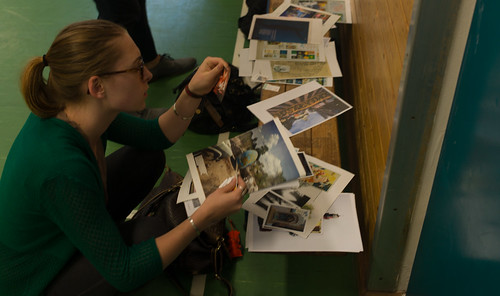

Instruction: Discuss briefly how would you answer the question above, then create a mood-board together, to visualise your answer (you can use words and images).
- Give a name to your scenario
- Make a mood-board to describe:
- the atmosphere and the key features of your scenario
- the answer to the core question in a few keywords or sentences
At the end of the exercise, the whole group comes together and the moodboards, scenarios and answers are presented to the group as a whole.


Day 2
Framing
Summary of the previous day, plans for the coming sessions, repeating the house rules (if needed). Q&A
Check-in
How are you?
Instruction: Going around in a circle, tell each other how you feel, but describe your mood as weather (e.g. the sun is shining just after a big storm).
Warm-up
Are you awake?
Instruction: stand up and give yourself a gentle 'beating' along all the bodily meridians. You can use your fists or your palms. Begin at your feet and work your way up to the head. At the end shake off any “excess energy” by shaking all your limbs and letting any residual tension dissolve.
Constellations
What can I learn about the scenarios, from a systemic/energetic/somatic point of view?
Test round: The facilitator writes down several possible holiday destinations (e.g. a seaside town, a mountain vista, rustic village, bustling metropolis). S/he places the papers in different parts of the room. The question is: which place are you drawn to, using your bodily instinct, without thinking too much?
Instruction: Begin by sensing what it feels like to stand - what's going on in your body and around your body, and in your mind? When it feels right, begin moving around the room, and feel whether you feel drawn, repulsed or neutral in different parts of the space. After exploring the space a bit, find the position that has the strongest sensation for you (no matter if it's positive or negative). You can stand, sit, lie down - whatever feels right. Remain in the same place for a while, in silence, and explore any sensations or images that might arise. After a few minutes, the facilitator invites you to share your findings with others in your neighbourhood. If you haven't chosen a particular position, observe from the outside what happens. At the end briefly share the experiences with the group, focusing on the types of sensations that you discovered.
Scenario Constellations: Learning from the test-round, create a constellation for the different scenarios. One facilitator places the names of the scenarios on the floor (in different parts of the room), the other reminds the participants of the axes that are the basis of the scenario. The group goes through the same process as in the test round. At the end of the exercise, the groups who have chosen particular positions move together to the break-out group of that scenario. People who didn't chose any positions can function as 'pollinators' and move between different scenarios.
In the breakout groups, summarise your findings about the pre-cognitive sensations related to each of the scenarios.
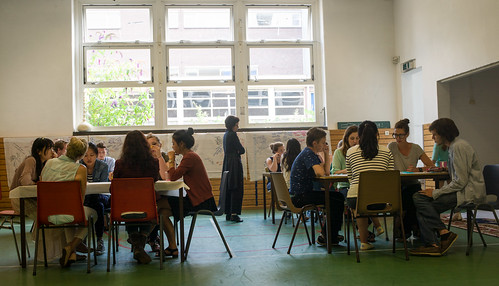
(Social) Systems
What happens to the change drivers in this world?
Instruction: Have a conversation about the development of the important drivers for this scenario. The following questions can help:
- Look at the drivers of change that we considered important and pick a few that you think will be crucial in your world.
- How might the drivers develop over five years? Will they become more or less relevant?
- How would the drivers influence visualizing the invisible?
- Which drivers might explain the underlying issues in this world?
- Who are the main protagonists in this scenario, who is visualizing the invisible? What are the relationships between the protagonists?
- Which systems (social, political, economic, technological…) are the dominant forces?
Worldviews
What are the dominant worldviews?
Instruction: Remain in the same breakout group if you still feel committed to this scenario. If not, feel free to move to another scenario at any point. Have a conversation about what might be the worldviews and beliefs underlying the problems and systems in this world. The following questions can help:
- What are the basic concepts and values in this world?
- What is overly visible in this future? What is invisible?
- What do people believe in?
- Are there any grand (unverifiable) statements emerging in this world?
- What deeply held perspectives might we come across?
- What might be the assumptions about visualizing the invisible that are common here?
Myths and stories
What are the foundational myths and stories?
Instruction: Remain in the same breakout group if you still feel committed to this scenario. If not, feel free to move to another scenario at any point. Have a conversation about what might be the worldviews and beliefs underlying the problems and systems in this world. The following questions can help:
- What is the history of this future? important events? significant moments?
- What would happen with the core issue (in our case, visualizing the invisible) as we know it today?
- What are the signals in the present or past that show that we might be going towards this future?
- How do the inhabitants feel? What might be the unconscious emotive dimensions underlying this world?
- Are there any archetypes or folk wisdom that could describe this world?
Design magazine

How do people of this world communicate about (the core issue) Visualizing the Invisible in design?
Instruction: create a design magazine called Visualizing the Invisible. Focus primarily on headlines, pull-quotes, themes and chapters. You can use words and images. The cover article should be about the core question of the workshop. At the end create the cover image as a “tableau vivant” and present your magazine to the whole group.


Re-focus on yourself
After lunch, a meditative exercise to return from externally oriented focus and turn our attention inward.
Instruction: Begin by sitting or lying down and focusing on your breathing. Then expand your attention to include your whole body, then further to include the air surrounding your body, and the sounds that the air brings to your ears. Expand further to include the whole room and the other people in it and then even further to all of the present and extended present, five years into the future. In a final broadening of your attention include the world you developed in your attention. Look around. What do you see? Where are you? What are you doing? How do you feel?
Pre-enactment scenario
Where am I in this scenario?
Instruction: It is the 11th of July 2019 and you are writing your diary. You might like to think about the following questions:
- How did I get from july 2014 to live in this future in 2019?
- What has happened in my life so that I ended up in this world?
- What kind of person am I? Where do I live? What do I do?
- What kind of people am I surrounded by?
- What is my relationship to design and creativity?
- How am I making invisible visible?
After about 15-20 minutes the facilitator sets another writing task. In the scenario, you have been invited to present at the Visualizing the Invisible Design festival, with the topic “how visualizing the invisible can change how we interact with the world”. What might be your contribution?
Pre-enactment
Preparing for the festival
Instruction:
- from now on you are yourself in 2019, living in the world you chose to write about. whatever happens, try to stay in your role in order not to “break the world”. if possible all questions should be asked from this role. The facilitators function as “game masters”, but do so in character (in their role as festival organisers in 2019)
- go back to the group of people from your world. Introduce yourselves and talk about each others' contributions to the festival. Are there any possibilities for collaboration?
- jointly prepare a lightning talk for the opening panel of the festival. the talk should describe your world and talk about the different contributions you're bringing to the festival.
- choose a spokesperson(s) who will participate in the panel
Opening panel
Instruction: representatives from different worlds present their lightning talks moderated by the facilitator. there is a short q&a from the 'audience',
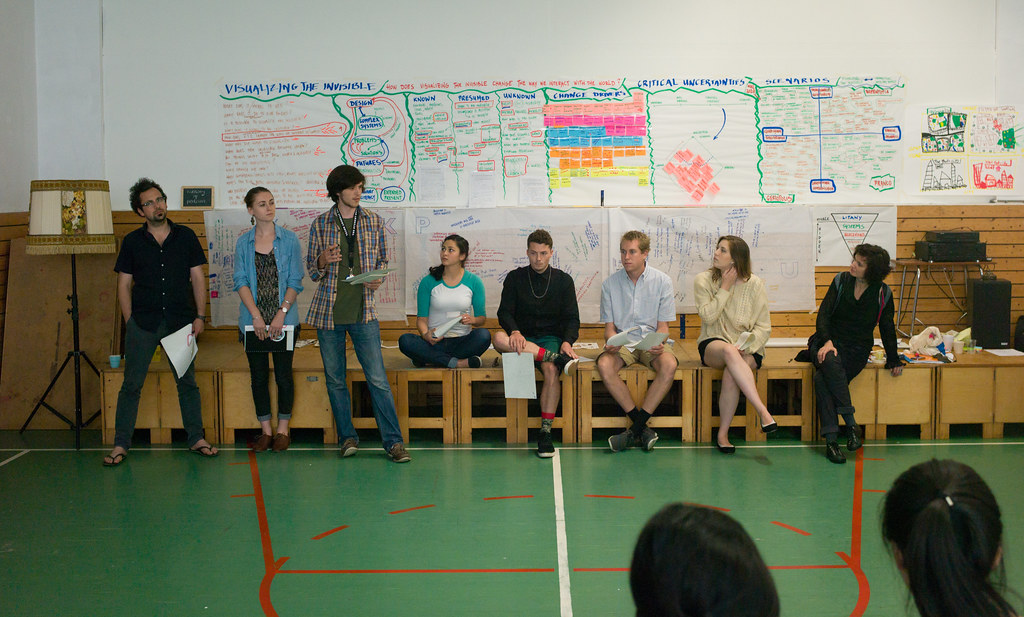
Appreciative Inquiry
What is visualizing the invisible in different contexts?
Instruction: as most interesting conversations on festivals and conferences happen outside of the official panels, the participants are invited to join a cocktail party, where they should find a representative from another world and have a dialogue with them. The dialogues should be structured as interviews: one person asks the question, the other answers. After the first round, the interviewers move to find another partner, who will interview them.
The conversations should be about the following: Think of a time (in your world from 2014 to 2019) when visualizing the invisible has changed the way you (or others) interact with the world. What did you do? How did you feel? What made it possible?
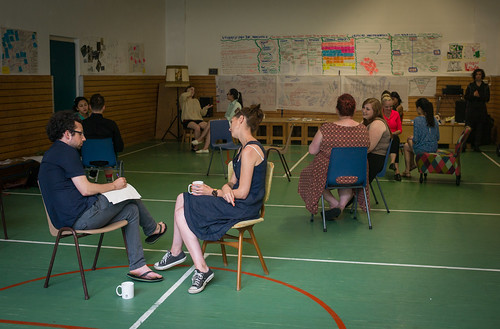
At the end of the two rounds, the group comes together in a circle. The facilitator explains that it is time to share the findings from the dialogues, but that instead of talking about yourself, you should share what you heard from the other person about themselves and their world. The facilitator will ask three questions: what did they do, how did they feel and what made their actions possible. The order of speaking will be decided by a “talking rock”: the person who holds the “rock” is the only one who can speak. After they are finished, they can throw the “rock” to the person whom they'd like to hear. One of the facilitator records the actions, emotions and resources that people are mentioning. After everyone has spoken, the facilitator summarises which actions, emotions and resources might be needed to visualize the invisible, in different possible futures, but also today.
Back to the present
Welcome back, how was your trip?
A small ritual to bring the group back to the present (we walked around our chairs), a short silent introspection and finally a round of reflections. We have done this in a “listening circle” using the “speaking rock” that was passed clock-wise around the circle. The focus of the reflection is on personal insights and anything that “bubbles up” - it can be about the experience, the scenarios, the process, personal insights, note of thanks - anything people feel like sharing. If someone doesn't feel ready to speak, they can pass the “rock” to the next person.
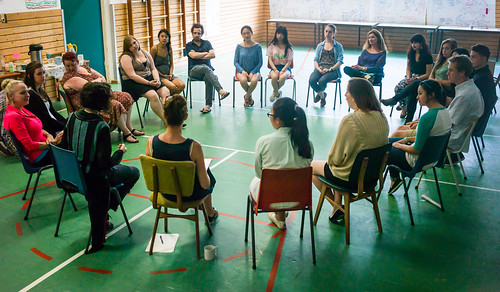
One clap
Instruction: warm up your hands in a circle. The facilitator counts back from three, and everyone claps their hands once, all at the same time.
